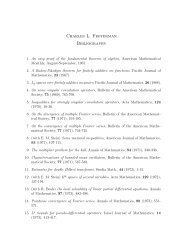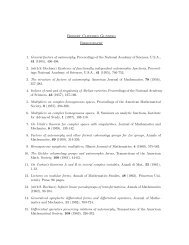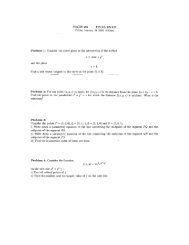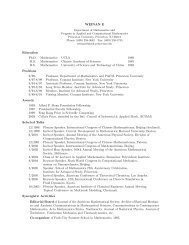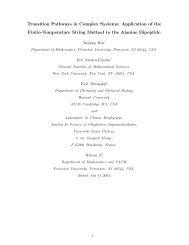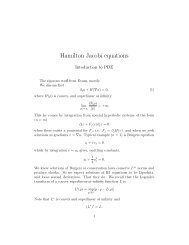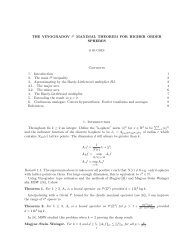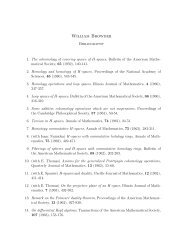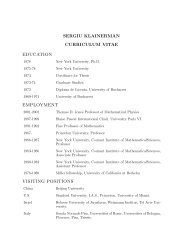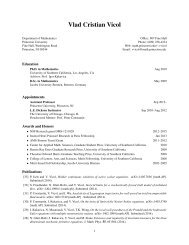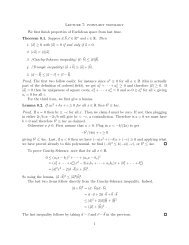The rational Khovanov homology of 3-strand pretzel links
The rational Khovanov homology of 3-strand pretzel links
The rational Khovanov homology of 3-strand pretzel links
You also want an ePaper? Increase the reach of your titles
YUMPU automatically turns print PDFs into web optimized ePapers that Google loves.
14 ANDREW MANION<br />
3. Preliminaries for the pro<strong>of</strong><br />
3.1. Skein sequences and cancellations. Our main computational tool will be the<br />
unoriented skein exact sequence in <strong>Khovanov</strong> <strong>homology</strong>, stated below.<br />
<strong>The</strong>orem 3.1. (See [10].) Let D be a diagram for an oriented link, and consider a<br />
crossing c. One <strong>of</strong> the two resolutions <strong>of</strong> c, say D o , is consistent with the orientations,<br />
and will be called the “oriented resolution.” One, say D u , is not (the “unoriented”<br />
resolution). Let ǫ = n − (D u )−n − (D), where n − denotes the number <strong>of</strong> negative crossings<br />
in a diagram. <strong>The</strong>n, if c is a positive crossing, we have the sequence<br />
· · ·<br />
f<br />
q 3ǫ+2 t ǫ+1 Kh(D u ) Kh(D) qKh(D o )<br />
If c is a negative crossing, we have the sequence<br />
f<br />
· · ·<br />
· · ·<br />
f<br />
q −1 Kh(D o ) Kh(D) q 3ǫ+1 t ǫ Kh(D u )<br />
f<br />
· · · .<br />
Schematically, the skein exact sequence will put us in the following situation: we have<br />
two known bigraded vector spaces V and W and a map f : V → W fitting in an exact<br />
sequence:<br />
f<br />
· · · W X V W · · · ,<br />
where X is unknown. Our goal will be to determine X. We know that f preserves<br />
q-grading and increases t-grading by one. Thus, X arises from “cancelling” pairs <strong>of</strong><br />
generators from V ⊕ W as in the following definition:<br />
Definition 3.2. Let V and W be bigraded vector spaces. A cancellation <strong>of</strong> V ⊕W is a<br />
subspace X <strong>of</strong> V ⊕ W obtained by eliminating “horizontal pairs,” i.e. two-dimensional<br />
subspaces Qv ⊕ Qw where v ∈ V , w ∈ W, v and w have the same q-grading, and the<br />
t-grading <strong>of</strong> w is one greater than the t-grading <strong>of</strong> v. For an example, see Figure 7.<br />
Hence we can determine X by looking at all possible cancellations <strong>of</strong> V ⊕ W and<br />
rejecting all but one <strong>of</strong> them. We will accomplish this task by using the structure<br />
<strong>of</strong> <strong>Khovanov</strong> <strong>homology</strong> coming from the Lee spectral sequence (see [6]). For <strong>links</strong><br />
with <strong>Khovanov</strong> <strong>homology</strong> contained entirely in three adjacent δ-gradings, this spectral<br />
sequence implies that the <strong>Khovanov</strong> <strong>homology</strong> breaks up into the knight’s moves and<br />
exceptional pairs discussed earlier (see Figure 3). Motivated by this fact, we make the<br />
following definition.<br />
Definition 3.3. A bigraded vector space V is well-structured if it is a sum <strong>of</strong> knight’s<br />
moves and exceptional pairs.<br />
For our sequences, all three spaces V , W, and X will be well-structured. Thus, in<br />
trying to determine X, we can first disregard all cancellations <strong>of</strong> V ⊕ W which are not<br />
well-structured. Out <strong>of</strong> the remaining options, it will turn out that we can uniquely<br />
f




